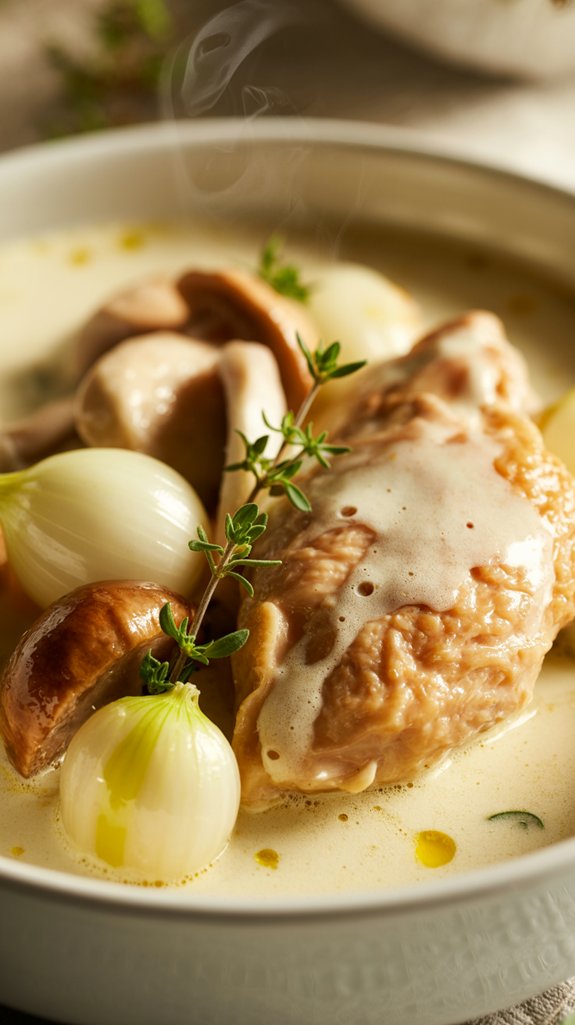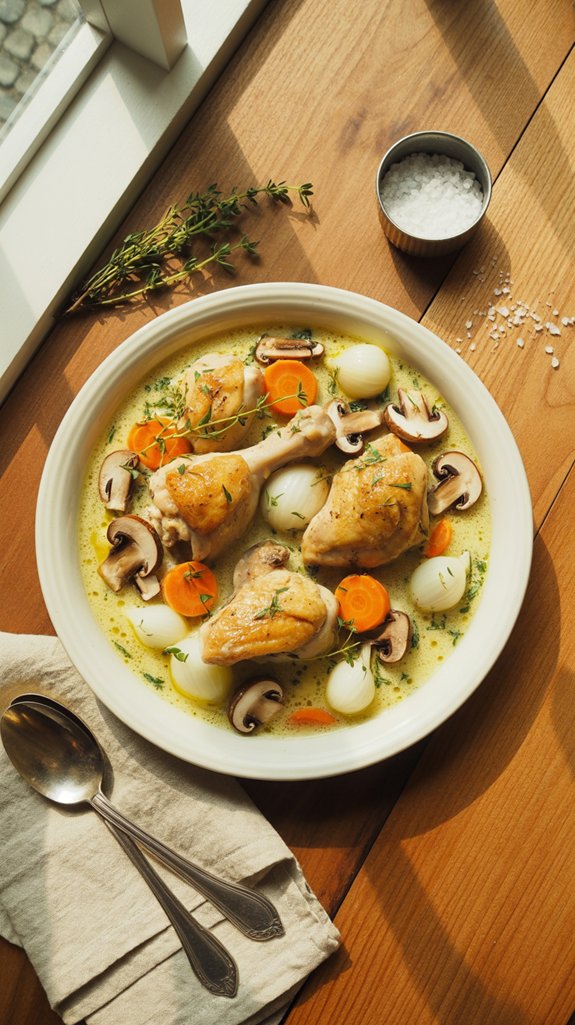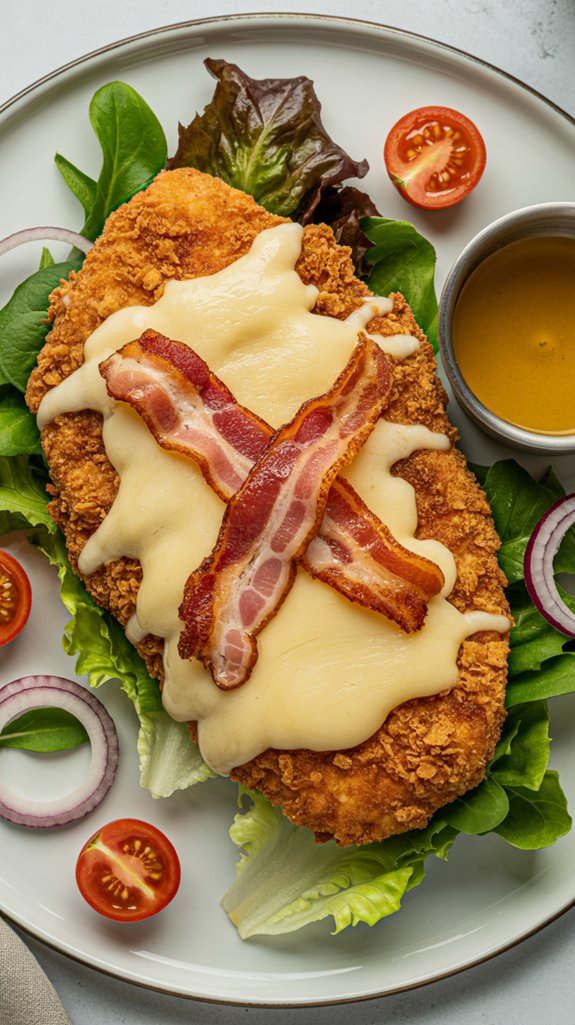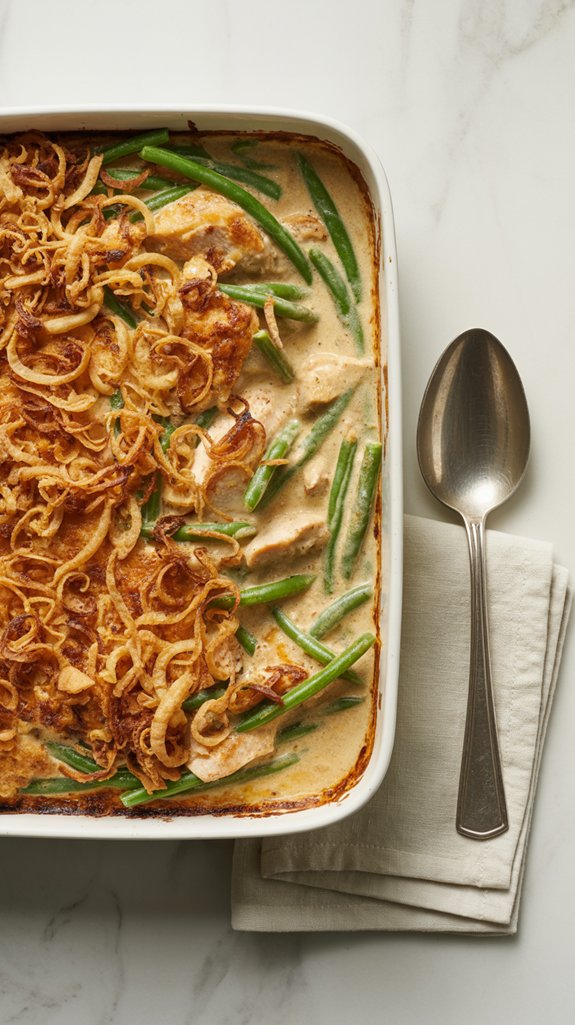Why You’ll Love This this French Chicken Fricassee
This French chicken fricassee transforms simple ingredients into something that feels fancy enough for company, but honestly, it’s just comfort food wearing a beret.
The chicken gets so tender after that long, slow simmer that it practically falls off the bone, while the creamy gravy develops this rich, savory depth that makes you want to lick the spoon (not that I’m judging if you do).
Those fluffy chive dumplings on top turn the whole thing into a complete, soul-warming meal that’ll have everyone asking for seconds, because who can resist chicken and dumplings with a little French flair?
Ingredients List
This French chicken fricassee calls for pantry staples that you probably already have hanging around, plus some fresh chicken and a few simple vegetables.
- 1 cup all-purpose flour
- 2 teaspoons salt
- 1/4 teaspoon pepper
- 2 teaspoons paprika (plus extra for sprinkling)
- 4 lbs chicken, cut-up
- Canola oil
- 1 large onion, chopped
- 2 teaspoons thyme
- 1 cup water
- Chicken broth
- 3 tablespoons flour (for gravy)
- Milk
- Chive dumplings (separate recipe)
A Few Things to Keep in Mind:
- The recipe uses a fair amount of flour for coating and thickening, so it’s not exactly light on carbs, but hey, comfort food rarely is
- You can swap the canola oil for olive oil if you want a bit more flavor, though it might change the taste slightly
- That 4 pounds of chicken feeds a crowd, so this isn’t exactly a weeknight dinner for two unless you want leftovers for days
- The milk in the gravy adds calcium and protein, which is nice, but you could use a lighter milk if you’re watching calories
- All that slow cooking actually breaks down the chicken into easily digestible protein, so your body will thank you even if your jeans might not
Step by Step Directions

This classic French chicken fricassee transforms simple ingredients into a rich, comforting meal through slow braising and a creamy gravy finish. Achieving the perfect sear and maintaining consistent heat throughout the braising process requires quality premium cookware sets that distribute heat evenly and retain temperature effectively.
Step-by-Step Directions:
- Mix 1 cup flour, salt, pepper, and 2 teaspoons paprika in a bowl for the coating mixture.
- Coat all chicken pieces thoroughly with the seasoned flour mixture.
- Heat a thin layer of canola oil in a large skillet or electric frying pan over medium heat.
- Brown the coated chicken pieces on all sides until golden, then drain and reserve the oil.
- Add water, chopped onion, and thyme to the skillet with the chicken.
- Cover and cook on low heat for 2½ to 3½ hours until chicken is tender and cooked through.
- Add chicken broth as needed if the mixture becomes too dry during cooking.
- Remove the cooked chicken from the pan and set aside, keeping it warm.
- Drain the cooking liquid from the skillet and reserve it for gravy.
- Heat 3 tablespoons of the reserved cooking liquid in the same skillet.
- Blend in 3 tablespoons flour and cook over low heat, stirring constantly until smooth and bubbly.
- Remove from heat and add enough milk to the remaining reserved liquid to measure 3 cups total.
- Pour the milk mixture into the skillet and heat to boiling while stirring constantly.
- Boil and stir for 1 minute to thicken the gravy.
- Return the chicken to the gravy in the skillet.
- Prepare chive dumplings according to separate recipe and drop spoonfuls onto the hot chicken.
- Cook exposed for 10 minutes, then cover and cook 20 minutes longer.
- Add more chicken broth if the mixture becomes too thick or starts sticking to the pan.
- Sprinkle with extra paprika before serving.
Substitutions and Variations
- Vegetable additions – Carrots, celery, and mushrooms can join the party during the braising step, because who doesn’t want more vegetables sneaking into their comfort food.
- Wine upgrade – Replace half the water with dry white wine for a more sophisticated flavor, though to be frank, you might end up drinking more wine than goes in the pot.
- Spice tweaks – Add a pinch of cayenne if you like a little heat, or throw in some garlic powder because garlic makes everything better.
- Dumpling alternatives – Skip the dumplings entirely and serve over rice, mashed potatoes, or egg noodles when you’re too tired to make another component from scratch.
Additional Things to Serve With This Dish
This fricassee pairs beautifully with sides that can soak up all that gorgeous, creamy gravy.
- Crusty bread – Because you absolutely need something to mop up every last drop of that sauce, and to be frank, watching people fight over the bread basket is half the entertainment.
- Simple green salad – A light vinaigrette cuts through all that richness, plus it makes you feel like you’re being healthy while eating what’s basically chicken swimming in gravy.
- Roasted root vegetables – Carrots, parsnips, or Brussels sprouts add some color to your plate and give you something to point to when people ask about your vegetable intake.
- Buttered green beans – Classic for a reason, and they’re one of the few vegetables that don’t mind being a little overdressed for the occasion.
- Rice pilaf – If you skipped the dumplings, rice becomes your gravy-absorbing hero, though to be frank, it’s doing all the heavy lifting here.
- Biscuits – Southern-style buttermilk biscuits turn this into a proper comfort food feast, assuming you have the energy to make yet another thing from scratch.
Cooking Tips & Tricks (Chef’s Notes)
After years of watching people struggle with fricassee, I’ve learned that success really comes down to patience and a few key tricks.
- Don’t rush the browning – That golden crust isn’t just for looks, it’s building the flavor foundation for your entire dish, so resist the urge to cram all the chicken pieces in at once like you’re playing Tetris.
- Keep your heat steady and low – High heat will give you tough, chewy chicken that tastes like it spent too much time at the gym, while low and slow creates that fall-off-the-bone tenderness we’re after.
- Save that fond – Those brown bits stuck to the bottom of your pan after browning are liquid gold, so scrape them up when you add the liquid and let them work their magic.
- Taste as you go – The difference between good fricassee and great fricassee often comes down to seasoning adjustments along the way, because recipes are guidelines, not gospel.
- Don’t overthicken the gravy – It should coat a spoon nicely but still flow freely, since it’ll continue thickening as it cools and nobody wants gravy that resembles wallpaper paste.
- Let it rest before serving – Give everything about 10 minutes to settle after cooking, which allows the flavors to meld and prevents you from burning your tongue in your enthusiasm.
- Make extra gravy – Trust me on this one, because there’s never enough and watching people ration their last spoonfuls is just heartbreaking.
Nutritional Facts
This hearty comfort dish provides substantial protein and energy, though the preparation method does add calories through browning and the rich gravy.
- Calories per serving: Approximately 485-520 calories (based on 6 servings)
- Protein: 35-40 grams per serving from the chicken, making this an excellent protein source
- Fat content: 25-30 grams per serving, primarily from the oil used for browning and natural chicken fat
- Carbohydrates: 20-25 grams per serving, mainly from the flour coating and gravy thickener
- Sodium: Moderately high due to added salt and any chicken broth used (varies by brand)
- Fiber: Minimal fiber content, roughly 1-2 grams per serving
- Vitamins: Good source of B vitamins (especially B6 and niacin) from chicken, plus vitamin A from paprika
- Minerals: Provides iron, phosphorus, and selenium from the chicken
- Cholesterol: Approximately 95-110mg per serving due to chicken content
- Saturated fat: About 7-9 grams per serving, primarily from chicken skin and cooking oil
- Healthier modifications: Remove skin before cooking, use less oil for browning, or substitute with cooking spray to reduce calories and fat
Fun “Did You Know?”
Beyond its nutritional benefits, chicken fricassee carries fascinating stories that’ll surprise you.
Did you know that fricassee actually predates most classic French cooking techniques by several centuries? The word “fricassee” comes from the French “fricasser,” meaning “to fry then stew.”
Medieval cooks developed this method to tenderize tough poultry while creating rich gravies. Curiously, fricassee recipes appeared in English cookbooks before many French ones!
The dish became so popular that colonial Americans adopted it as comfort food.
Today’s version maintains those ancient principles: browning meat first, then slow-cooking in liquid creates the signature tender texture we love.





